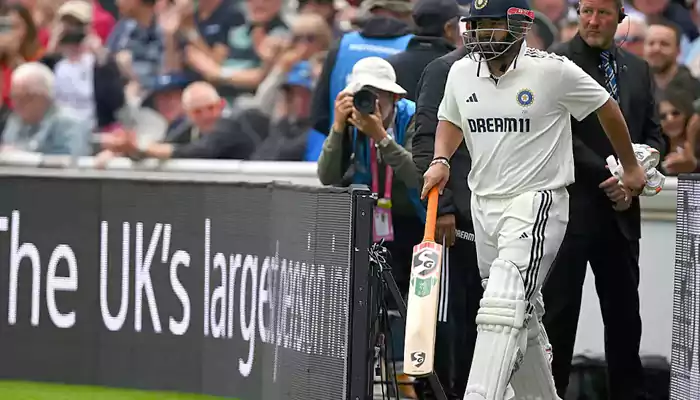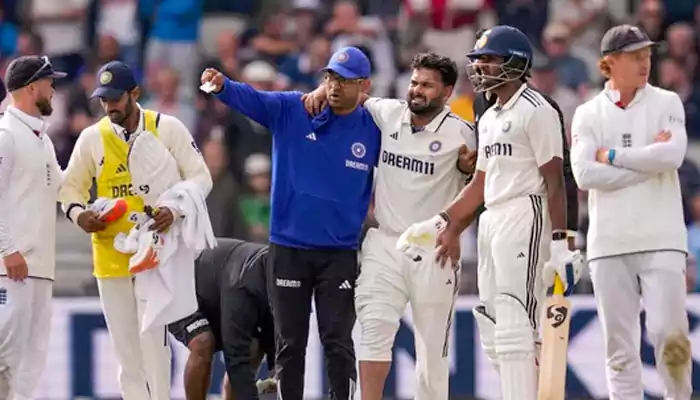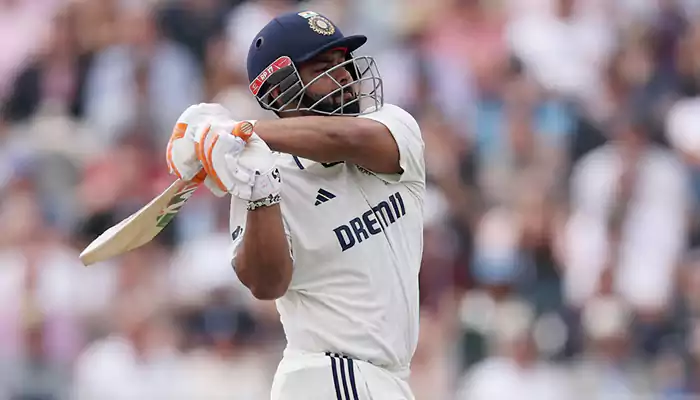
Rishabh Pant's impact in this series has been a blazing torch - illuminating brilliance shadowed by risk. His audacity on the crease transcends mere cricket, raising a pressing question: when the body screams caution, should a warrior still charge, or does the cause demand prudence?
Pant's approach never follows the rules. In July 2025 at Old Trafford, he defied logic and medical advice, stepping onto the field with a fractured metatarsal, a fresh wound hidden beneath his whites. His foot-once a source of stability-is now the size of an egg, a reminder of vulnerability, yet his bat swung like a sword driven by recklessness and purpose.
This wasn't a mere cameo to scrape a draw; India was well into their first innings, battling against the seaming Duke ball. Still, Pant chose to bear the load, limping but maintaining a fearless rhythm that contradicted his injury. It was as if he challenged the game itself: "Test me if you will."

Credit: Cricbuzz
The metaphor here is fitting - Pant's decision to bat was like dancing on a live wire, electrifying yet dangerous. Every run taken was a gamble, each step a balancing act between pain and purpose.
Batting with a fractured foot doesn't just threaten a player's body; it jeopardises the team's stability. In Test cricket's chess game, losing a key batter to injury early can trigger a chain reaction of collapses. Pant's presence at the crease provided runs but also invited England's strategic targeting of his injury — deliveries angled low, probing the weakness.
Yet the gamble paid off. Pant's aggressive fifty, edged with skilful cuts and fierce pulls, boosted momentum for India's innings. His six off Jofra Archer wasn't just more runs; it was a loud statement of defiance.

Here lies the conundrum: does valour excuse vulnerability? Pant's heroics evoke memories of cricket's legendary warriors—Graeme Smith's fractured hand at Sydney, Anil Kumble's broken jaw spells—moments etched into cricket's collective memory for their courage.
But Test cricket is a marathon of attrition, not a highlight reel of bravado. Is it fair to the team, the player, or the sport to valorise risking long-term fitness for short-term gain? Pant's fractured foot is a ticking time bomb; one misplaced step could sideline him for months, a heavy price on the altar of grit.
The decision to let Pant bat wasn't solely his own. The management, medical staff, and captaincy faced a dilemma as complex as any geopolitical strategy—balancing Pant's exceptional talent against the risk of losing him entirely.
As Pant moved for singles and launched daring strokes, India's innings gained momentum. But was it a pulse that sustained life, or a fever risking collapse?

Credit: Crictracker
In the crucible of this series, Pant's innings will resonate beyond mere statistics. His 54 under pressure speaks volumes—runs crafted not only with skill but with sheer determination. More than just numbers, this stands as a testament to cricket's timeless tug-of-war: between the instinct to fight and the wisdom to withdraw.
Pant's daring was a high-stakes wager, a microcosm of Test cricket's eternal drama. When the body falters but the spirit remains fiery, should a player risk everything to lead the way, or conserve the flame for battles yet to come?
The answer lies not solely in runs or records, but in the spirit of the game—a balance as fragile as Pant's own fractured foot on that tumultuous pitch.